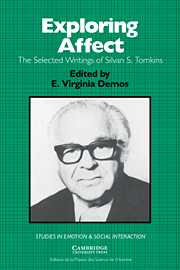Book contents
- Frontmatter
- Contents
- Foreword
- Editor's preface
- List of contributors
- Chronology
- Introduction
- Part I Affect theory
- Introduction
- Selections by Silvan S. Tomkins
- The quest for primary motives: Biography and autobiography of an idea
- Evolution of the affect system
- Role of the specific affects
- Modifications in the theory – 1978
- Part II Affect and ideology
- Introduction
- Selections by Silvan S. Tomkins
- Part III The face of affect
- Introduction
- Selections by Silvan S. Tomkins
- Part IV Script theory: The differential magnification of affect
- Introduction
- Selections by Silvan S. Tomkins
- Part V Human being theory: A foundation for the study of personality
- Introduction
- Selections by Silvan S. Tomkins
- A complete annotated bibliography of Silvan S. Tomkins's writings
- References
- Author index
- Subject index
- Titles in the series
Evolution of the affect system
Published online by Cambridge University Press: 10 November 2010
- Frontmatter
- Contents
- Foreword
- Editor's preface
- List of contributors
- Chronology
- Introduction
- Part I Affect theory
- Introduction
- Selections by Silvan S. Tomkins
- The quest for primary motives: Biography and autobiography of an idea
- Evolution of the affect system
- Role of the specific affects
- Modifications in the theory – 1978
- Part II Affect and ideology
- Introduction
- Selections by Silvan S. Tomkins
- Part III The face of affect
- Introduction
- Selections by Silvan S. Tomkins
- Part IV Script theory: The differential magnification of affect
- Introduction
- Selections by Silvan S. Tomkins
- Part V Human being theory: A foundation for the study of personality
- Introduction
- Selections by Silvan S. Tomkins
- A complete annotated bibliography of Silvan S. Tomkins's writings
- References
- Author index
- Subject index
- Titles in the series
Summary
Modern evolutionary theory portrays man as an adapted organism, fearfully and wonderfully made, but also imperfectly adapted because he is a patchwork thrown together, bit by bit, without a plan, remodeled opportunistically as occasions permitted. The conjoint operation of blind mutation, genetic recombination and natural selection contrived that magnificent makeshift, the human being.
There is a consensus according to Simpson that it is the population of genes rather than the genes of any individual which is governed by natural selection. Since a population maintains itself by diversity of genes, every variant (particular combination of genes) need not maintain itself any more than a single individual ceases to exist because he is continually replacing aging tissue, e.g., his skin. Secondly, in some contrast to Darwin's views, natural selection by reproduction is held to be the only non-random selective factor. The problem of adaptation then has shifted somewhat from the problem how does an individual “survive” to how does a population of genes maintain itself through correlations between reproductive success and adaptation. From this position, in addition to a strong sex drive, such characteristics as sensitivity to novel stimuli, sensitivity to social stimuli, aggressiveness, timidity and other affects become no less important foci for natural selection than the development of a homeostatic autonomic system and an adapted drive system. The individual must not only survive – he must reproduce himself in such quantity that his kind continues to reproduce itself.
- Type
- Chapter
- Information
- Exploring AffectThe Selected Writings of Silvan S Tomkins, pp. 64 - 67Publisher: Cambridge University PressPrint publication year: 1995



